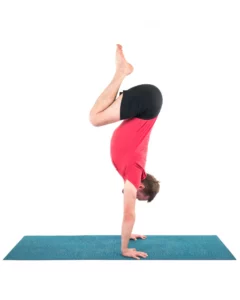Yoga Practice Tips: Let’s Redefine ‘Advanced Yoga’

In 30 years of teaching, I can’t even begin to relate how many times I’ve heard people say that they can’t do yoga because they’re not flexible. Similarly, I wish I had a dollar for all the times I’ve heard a longtime student declare themself to be “just” a beginner because in all these years they have never touched toes in a forward bend or done Upward Bow with straight arms.
What is “Advanced Yoga”?
I read a blog lamenting the yoga cultural emphasis on “advanced” yoga poses and how all the social media photos of yoga practitioners in these poses are likely scaring people away from yoga practice. This is probably true and certainly a valid concern. But I want to take the discussion further and ask: “What is advanced yoga anyway?”
Is “advanced yoga” the ability to slip easily into full Pigeon Pose (Kapotasana)? Is it the ability to wedge your ankle behind your head? Is rocking arm balances on the beach advanced yoga?
To be sure, accomplishing yoga poses such as these—along with many more extreme ones—can show determination and discipline. My dad was a gymnast. Even when he was in his 60s, the discipline it took for him to compete when he was younger served him well. He was in better physical condition for his entire adult life than most people half his age.
There’s nothing wrong with wanting to challenge our bodies. But the truth about the yoga poses that are widely considered to be “advanced” is that they will only ever be accessible to a small portion of the population, no matter how many decades we’ve practiced asana. Their practical benefits in terms of allowing our bodies to function with ease in our everyday lives are questionable.
The Pursuit of Bendy in Yoga

We’re all built differently. Some of us are born with stable joints and strong ligaments. Some of us are born with shallow joints and loose ligaments. A person with stable joints may have perfectly relaxed soft tissue, but still have limited mobility because range of motion is limited by one bone running into another at a joint site. A person with loose or shallow joints will simply be able to move their joints further before encountering bony contact.
Over the years, I’ve encountered a number of students who could do “advanced” poses on their very first day of a yoga class. Does that make them advanced yoga practitioners? Conversely, I’ve observed students with decades of practice who can’t touch their toes. Does that make them beginners?
Most of us can maintain and even increase our flexibility with consistent asana practice. But to what end? Is ever-increasing flexibility a goal to covet? Maintaining and increasing flexibility within limits is probably a positive for a person who tends toward the stiffer side. For a person who’s naturally flexible—often the people who become attracted to asana in the first place because, “I can do this!”—not so much.
As a person born with loose joints, including the hip dysplasia that has enabled me to perform all kinds of amazing feats of flexibility, I’ve had to rethink the popular Western notion that more flexibility is always better.
When naturally flexible people practice asana, going too far is almost inevitable. In order to feel something—anything—we flexies have to push our joints to their healthy limits and beyond. Never mind that the point of yoga practice is not to “feel a stretch.” The real issue is that pushing our joints to the limit further destabilizes them by stretching ligaments and wearing down cartilage as bone grinds against bone.
For a naturally flexible person, building stability—not more flexibility—creates balance. I’d argue that a naturally flexible person doing fancy yoga poses that require hypermobility could be in the beginning, rather than advanced, stage of his/her practice. Here’s why:
Steady and Comfortable Yoga

Remember this: shtira sukkhan asanam? According to Alistair Shearer, Sutra 2.46 means, “The physical posture is steady and comfortable.” Hmmm. “Steady” implies stability, and “Comfort” implies ease. There is nothing in there about being über-flexible. And here’s Sutra 2.47: “[Asana] is mastered when all effort is relaxed, and the mind is absorbed in the Infinite.”
Advanced yoga asana has nothing to do with what your body is capable or incapable of performing. It has everything to do with developing the awareness and sensitivity to practice asana from a place of ease, presence, and contentment with what is. It is learning to partner with your body rather than trying to conquer it.
I tell my students this all the time: When I see a person in my class backing away from doing the “full” pose, sitting out a pose and doing something else entirely, or resting deeply in a simple, so-called “beginning” pose, that is advanced yoga. When I observe my students resting in the present reality of their asana practice—no matter what it looks like—without straining, pushing or judging themselves for a perceived deficit of yoga ability, I’m elated. Their minds are at ease, fully present and content—even grateful—to be in their bodies as they are right in that very moment. That is mastery.
Inquiring into Your Yoga Practice

Here are some questions you might consider asking yourself as you practice yoga:
- How is my breathing? If your breath is not free and easy, mastery (according to Sutra 2.47) won’t be possible.
- Where am I feeling stretching sensation? Is it in soft tissue along the bones? Probably okay. Is it in a joint or joints? Back off.
- What’s my mind up to? Do I feel that my current practice is deficient in some way? Do I feel that my current practice is superior? Both these things are judgments that get in the way of actual yoga (the settling of the mind into silence). Practice is just what it is—practice. It’s not a performance. Simply be present.
- Instead of asking the question, “What more can I do to go further in this pose?” try asking yourself, “What can I stop doing that’s getting in the way of my experiencing this pose here and now?” Remember that yoga asana asks us to partner with our bodies to create a state of ease and stability, a place where our minds can find rest. The goal of asana is the stilling of the mind. “Advanced yoga,” however we choose to define it, isn’t the goal. We can be at ease any time when we let go of the idea that outward manifestations of poses are the point. The journey is inward, and it leads you to this very moment.
Remember that yoga asana asks us to partner with our bodies to create a state of ease and stability, a place where our minds can find rest. The goal of asana is the stilling of the mind. “Advanced yoga,” however we choose to define it, isn’t the goal. We can be at ease any time when we let go of the idea that outward manifestations of poses are the point. The journey is inward, and it leads you to this very moment.
Also, read...
Working with the Fascial Network: The Art of Self-Myofascial Release
Simplify Your Yoga Cues to Increase Their Power
Related courses
Breath as Medicine: Yogic Breathing for Vital Aging
Yoga and Myofascial Release: Releasing Chronic Tension with the Bodymind Ballwork Method

Charlotte Bell began practicing yoga in 1982 and began teaching in 1986. She was certified by B.K.S. Iyengar in 1989 following a trip to Pune. In 1986, she began practicing Insight Meditation with her mentors Pujari and Abhilasha Keays. Her asana classes blend mindfulness with physical movement. Charlotte writes a column for Catalyst Magazine and serves as editor for Yoga U Online. She is the author of two books: Mindful Yoga, Mindful Life, and Yoga for Meditators, both published by Rodmell Press. She also edits Hugger Mugger Yoga Products’ blog and is a founding board member for GreenTREE Yoga, a non-profit that brings yoga to underserved populations. A lifelong musician, she plays oboe and English horn in the Salt Lake Symphony and the folk sextet Red Rock Rondo whose 2010 PBS music special won two Emmys.



